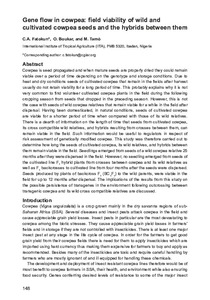| dc.contributor.author | Fatokun, C.A. |
| dc.contributor.author | Boukar, O. |
| dc.contributor.author | Tamo, M. |
| dc.date.accessioned | 2019-12-04T11:07:47Z |
| dc.date.available | 2019-12-04T11:07:47Z |
| dc.date.issued | 2012 |
| dc.identifier.citation | Fatokun, C., Boukar, O. & Tamo, M. (2012). Gene flow in cowpea: field viability of wild and cultivated cowpea seeds and the hybrids between them. In O. Boukar, O. Coulibaly, C. Fatokun, K. Lopez & M. Tamo, Innovative research along the cowpea value chain: proceedings of the fifth World Cowpea conference on improving livelihoods in the cowpea value chain through advancement in science, held in Saly, Senegal, 27 September-1 October 2010 (p.148-161), International Institute of Tropical Agriculture. |
| dc.identifier.isbn | 978-978-8444-07-7 |
| dc.identifier.uri | https://hdl.handle.net/20.500.12478/1590 |
| dc.description.abstract | Cowpea is seed propagated and when mature seeds are properly dried they could remain viable over a period of time depending on the genotype and storage conditions. Due to heat and dry conditions seeds of cultivated cowpea that remain in the fields after harvest usually do not retain viability for a long period of time. This probably explains why it is not very common to find volunteer cultivated cowpea plants in the field during the following cropping season from seeds that dropped in the preceding season. However, this is not the case with seeds of wild cowpea relatives that remain viable for a while in the field after dispersal. Having been domesticated, in natural conditions, seeds of cultivated cowpea are viable for a shorter period of time when compared with those of its wild relatives. There is a dearth of information on the length of time that seeds from cultivated cowpea, its cross compatible wild relatives, and hybrids resulting from crosses between them, can remain viable in the field. Such information would be useful to regulators in respect of risk assessment of genetically modified cowpea. This study was therefore carried out to determine how long the seeds of cultivated cowpea, its wild relatives, and hybrids between them remain viable in the field. Seedlings emerged from seeds of a wild cowpea relative 25 months after they were dispersed in the field. However, no seedling emerged from seeds of the cultivated line F1 hybrid plants from crosses between cowpea and its wild relatives as well as F1 backcrosses to cultivated line from four months after the seeds were dispersed. Seeds produced by plants of backcross F1 (BC1F1) to the wild parents, were viable in the field for up to 12 months after dispersal. The implications of the results from this study on the possible persistence of transgenes in the environment following outcrossing between transgenic cowpea and its wild cross compatible relatives are discussed. |
| dc.description.sponsorship | Swiss National Science Foundation |
| dc.format.extent | 148-155 |
| dc.language.iso | en |
| dc.publisher | International Institute of Tropical Agriculture |
| dc.subject | Cowpeas |
| dc.subject | Seedlings |
| dc.subject | Insecticides |
| dc.subject | Genotypes |
| dc.subject | Storage Conditions |
| dc.subject | Grain Legumes |
| dc.title | Gene flow in cowpea: field viability of wild and cultivated cowpea seeds and the hybrids between them |
| dc.type | Book Chapter |
| dc.description.version | Peer Review |
| cg.contributor.crp | Grain Legumes |
| cg.contributor.affiliation | International Institute of Tropical Agriculture |
| cg.coverage.region | Africa |
| cg.coverage.region | West Africa |
| cg.coverage.country | Nigeria |
| cg.authorship.types | CGIAR single centre |
| cg.iitasubject | Cowpea |
| cg.iitasubject | Genetic Improvement |
| cg.iitasubject | Grain Legumes |
| cg.iitasubject | Plant Genetic Resources |
| cg.howpublished | Formally Published |
| cg.publicationplace | Ibadan, Nigeria |
| cg.accessibilitystatus | Limited Access |
| local.dspaceid | 82272 |
| cg.targetaudience | Scientists |

